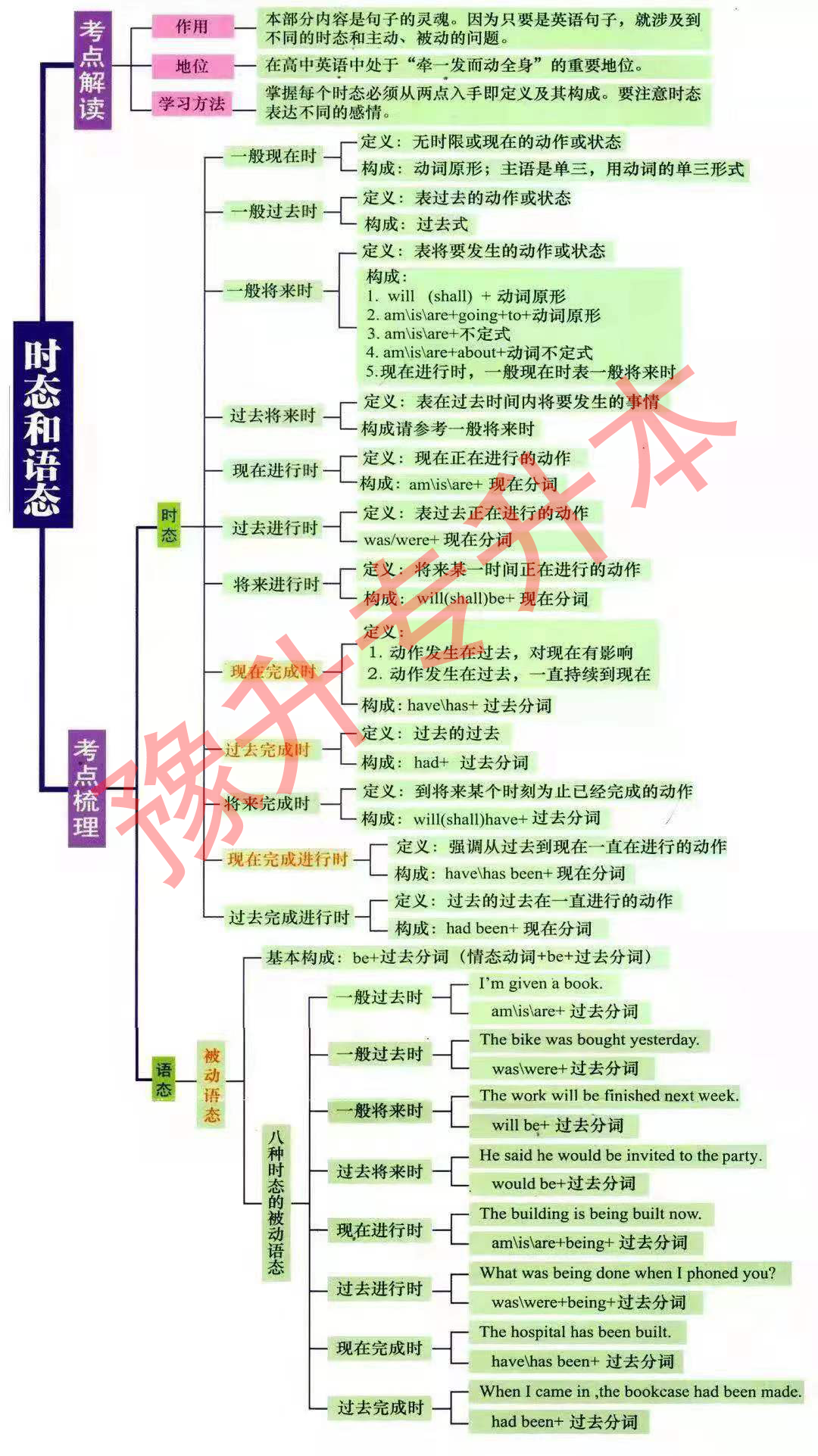- 关注我们:
-
微信公众号

- 豫升掌上英语App下载
秒懂英语8大基本时态,刚开始专升本备考的英语零基础学生必看!
时态是英语中一个重要的语法范畴,它表示不同时间发生的动作或存在的状态以及动作发生或存在的方式。
动作发生的时间可分为现在、过去、将来和过去将来四种形式,动作发生的方式可分为一般、完成、进行和完成进行四种形式。
英语中的八个基本时态,即:一般现在时、一般过去时、一般将来时、过去将来时、现在进行时、过去进行时、现在完成时、过去完成时。
有的人学了12年英语,现在还是不懂英语语法。小编整理了英语8大基本时态的相关内容,专升本英语零基础的同学赶快学起来!

一、一般现在时
1.概念:指经常、反复发生的动作或行为及现在的某种状况。
2.时间状语:always, usually, often, sometimes, every week (day, year, month…), once a week, on Sundays,
3.基本结构:动词+ 原形 (如主语为第三人称单数,动词上要加(e)S)
4.否定形式:am/is/are+not;此时态的谓语动词若为行为动词,则在其前加don't,如主语为第三人称单数,则用doesn't,同时还原行为动词。
5.一般疑问句:把be动词放于句首;用助动词do提问,如主语为第三人称单数,则用does,同时,还原行为动词。
6.例句:. It seldom snows here.
He is always ready to help others.
Action speaks louder than words.
7.特殊用法:一些动词可用一般现在时来表达现在进行时:
verbs of the senses: hear,see,taste,smell
verbs of the thinking: believe,know,mean,realize,think,remember
二、一般过去时
1.概念:过去某个时间里发生的动作或状态;过去习惯性、经常性的动作、行为。
2.时间状语:ago, yesterday, the day before yesterday, last week(year, night, month…), in 1989, just now, at the age of 5, one day, long long ago, once upon a time, etc.
3.基本结构:含有Be动词主语+was/were+形容词或者名词......
不含有be动词:主语+动词过去式+......
4.否定句:带be:主语+was/were not+形容词或者名词+......
不带be:主语+didn't+动词原形+......
5.一般疑问句:含be动词was或were放于句首;
不含be动词用助动词do的过去式did 提问,同时还原行为动词原型。
Did+主语+动词原形+……?
6.例句:She often came to help us in those days.
I didn't know you were so busy. [1]
She sang a song of Lin Feng yesterday [2] .
三、现在进行时
1.概念:表示现阶段或说话时正在进行的动作及行为。
2.时间状语:now, at this time, these days, etc.
3.基本结构:Be动词(am/is/are)+doing
4.否定形式:Be动词(am/is/are)+not+doing.
5.特殊疑问句:把be动词放于疑问词的后面。
6.例句:How are you feeling today?
He is doing well in his lessons.
7. 一般表示位移的词如leave fly arrive go come. 等用现在进行时表将来。
I am flying Beijing next week .表示我下周即将飞往北京。
He is leaving for Beijing tomorrow. 他明天即将去北京。
8.现在进行时就是一个动词后面加ing
四、过去进行时
1.概念:表示过去某段时间或某一时刻正在发生或进行的行为或动作。
2.时间状语:at this time yesterday, at that time或以when引导的谓语动词是一般过去时的时间状语等。
3.基本结构:was/were + doing
4.否定形式:was/were + not + doing.
5.一般疑问句:把was或were放于句首。
6.例句:At that time she was working in a PLA unit.
When he came in, I was reading a newspaper.
五、现在完成时
1.概念:过去发生或已经完成的动作对现在造成的影响或结果,或从过去已经开始,持续到现在的动作或状态。
2.时间状语:recently, lately, since…for…,in the past few years, etc.
3.基本结构:have/has + done
4.否定形式:have/has + not + done.
5.一般疑问句:have或has提前。
6.例句:I've written an article.
It has been raining these days.
六、过去完成时
1.概念:以过去某个时间为标准,在此以前发生的动作或行为,或在过去某动作之前完成的行为,即“过去的过去”。
2.时间状语:before, by the end of last year(term, month…),by the time...,etc.
3.基本结构:had + done.
4.否定形式:had + not + done.
5.一般疑问句:had放于句首。
6.例句:As soon as we got to the station, the train had left.
By the end of last month,we had reviewed four books
七、一般将来时
1.概念:表示将要发生的动作或存在的状态及打算、计划或准备做某事。
2.时间状语:tomorrow, next day(week, month, year…),soon, in a few minutes, by…,the day after tomorrow, etc.
3.基本结构:am/is/are + going to + do;will/shall + do.
4.否定形式:am/is/are + not+going to;will/shall+not(will适用于所有人称,shall只用于第一人称)
5.一般疑问句:be放于句首;will/shall提到句首。
6.例句:They are going to have a competition with us in studies.
It is going to rain.
I think he will be back soon
八、过去将来时
1.概念:立足于过去某一时刻,从过去看将来,常用于宾语从句中。
2.时间状语:the next day(morning, year…),the following month(week…),etc.
3.基本结构:was/were + going to + do;would/should + do.
4.否定形式:was/were + not + going to + do;would/should + not + do.
5.一般疑问句:was或were放于句首;would/should 提到句首。
6.例句:He said he would go to Beijing the next day.
I asked who was going there .
如果你基础不好或者零基础的学生,在目前专升本要提前考试的形势下想要快速提高成绩,那么可以考虑豫升专升本全日制二期,于8月4日即将开课!










